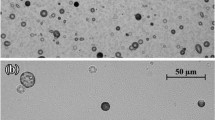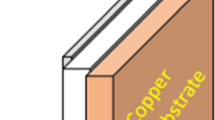Abstract
To overcome the limitation of CR-39 at high dose region where large number of tracks are overlapped, the FTIR spectroscopic technique can be implemented for dose estimation. In the present work, CR-39 detectors were irradiated with alpha particles from 239Pu source having known doses up to 5.12 Gy. The detectors were subjected to chemical etching in steps of 1 h and subsequently FTIR spectra were recorded. Three strong bands i.e., 1800–1675 cm−1, 1350–1150 cm−1 and 810–760 cm−1 in the FTIR spectra were analysed to study the effect of etching and dose on the peak absorbance of these bands. The peak absorbance was found to decrease with the dose as well as with etching duration and the saturation effect in the peak absorbance was observed above 3 h etching. Etching duration of 2 h was found to be optimal etching time where the linear response was observed up to 5.12 Gy. Furthermore, the threshold for dose estimation by the FTIR spectroscopic technique was observed to be 0.41 Gy, above which this technique can be used. Empirical relations correlating the peak absorbance and dose were generated which can be used as calibration factors for dose estimation in the range 0.41–5.12 Gy using the peak intensity in FTIR spectrum of CR-39 detector.







Similar content being viewed by others
References
Phillips GW, Spann JE, Bogard JS, VoDinh T, Emfietzoglou D, Devine RT et al (2006) Neutron spectrometry using CR-39 track etch detectors. Radiat Prot Dosim 120:457–460
Castillo F, Espinosa G, Golzarri JI, Osorio D, Rangel J, Reyes PG et al (2013) Fast neutron dosimetry using CR-39 track detectors with polyethylene as radiator. Radiat Meas 50:71–73
Doke T, Hayashi T, Nagaoka S, Ogura K, Takeuchi R (1995) Estimation of dose equivalent in STS-47 by a combination of TLDS and CR-39. Radiat Meas 24:75–82
Amemiya K, Takahashi H, Nakazawa M, Shimizu H, Majima T, Nakagawa Y et al (2002) Soft X-ray imaging using CR-39 plastics with AFM readout. Nucl Instrum Methods Phys Res Sect B 187:361–366
Li WY, Chan KF, Tse AKW, Fong WF, Yu KN (2006) Studies of biocompatibility of chemically etched CR-39 SSNTDs in view of their applications in alpha-particle radiobiological experiments. Nucl Instrum Methods Phys Res Sect B 248:319–323
Szeiler G, Somlai J, Ishikawa T, Omori Y, Mishra R, Sapra BK et al (2012) Preliminary results from an indoor radon thoron survey in Hungary. Radiat Prot Dosim 152:243–246
Young DA (1958) Etching of radiation damage in lithium fluoride. Nature 182:375–377
Tommasino L (1970) Seventh international colloquium corpuscular photography and visual solid detectors
Su C (1990) Revelation of nuclear tracks in plastic nuclear track detectors by ultrasonic etching. Radiat Prot Dosim 34:51–54
Tripathy SP, Kolekar RV, Sunil C, Sarkar PK, Dwivedi KK, Sharma DN (2010) Microwave-induced chemical etching (MCE): a fast etching technique for the solid polymeric track detectors (SPTD). Nucl Instrum Methods Phys Res Sect A 612:421–426
Bouffard S, Balanzat E, Leroy C, Busnel JP, Guevelou G (1997) Cross-links induced by swift heavy ion irradiation in polystyrene. Nucl Instrum Methods Phys Res Sect B 131:79–84
Calcagno L, Compagnini G, Foti G (1992) Structural modification of polymer films by ion irradiation. Nucl Instrum Methods Phys Res Sect B 65:413–422
Klaumünzer S, Zhu QQ, Schnabel W, Schumacher G (1996) Ion-beam-induced crosslinking of polystyrene—still an unsolved puzzle. Nucl Instrum Methods Phys Res Sect B 116:154–158
Marletta G (1990) Chemical reactions and physical property modifications induced by keV ion beams in polymers. Nucl Instrum Methods Phys Res Sect B 46:295–305
Knoll GF (2000) Radiation detection and measurement, 3rd edn. Wiley, New York
Yousef HA (2017) Effect of alpha particles on the bulk etching rate of CR-39 nuclear track detector. J Nucl Part Phys 7:23–26
Martin JE (2006) Physics for radiation protection: a handbook, 2nd edn. WILEY-VCH Verlag GmbH & Co. KGaA, Weinheim
Berger MJ, Coursey JS, Zucker MA, Chang J (2005) ESTAR, PSTAR, and ASTAR: computer programs for calculating stopping-power and range tables for electrons, protons, and helium ions (version 1.2.3). National Institute of Standards and Technology, Gaithersburg
Shakeri Jooybari B, Afarideh H, Lamehi-Rachti M, Ghergherehchi M (2015) Ablation and cone formation mechanism on CR-39 by ArF laser irradiation. J Appl Phys 117:093104
Sahoo GS, Tripathy SP, Joshi DS, Bandyopadhyay T (2016) Study of variations in structural, optical parameters and bulk etch rate of CR-39 polymer due to electron irradiation. J Appl Phys 120:025107
Sahoo GS, Paul S, Tripathy SP, Sharma SC, Jena S, Rout S et al (2014) Effects of neutron irradiation on optical and chemical properties of CR-39: potential application in neutron dosimetry. Appl Radiat Isot 94:200–205
Kumar V, Sonkawade RG, Chakarvarti SK, Kulriya P, Kant K, Singh NL et al (2011) Study of optical, structural and chemical properties of neutron irradiated PADC film. Vacuum 86:275–279
Acknowledgements
Authors are thankful to Shri R M Suresh Babu, Associate Director, Health, Safety and Environment Group for his continuous support and encouragement.
Author information
Authors and Affiliations
Corresponding author
Additional information
Publisher's Note
Springer Nature remains neutral with regard to jurisdictional claims in published maps and institutional affiliations.
Rights and permissions
About this article
Cite this article
Sahoo, G.S., Tripathy, S.P., Roy, R. et al. A new approach for high-dose measurement using CR-39 track detector. J Radioanal Nucl Chem 325, 765–771 (2020). https://doi.org/10.1007/s10967-020-07232-3
Received:
Published:
Issue Date:
DOI: https://doi.org/10.1007/s10967-020-07232-3




